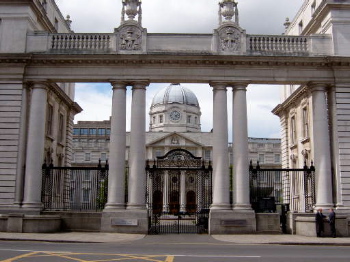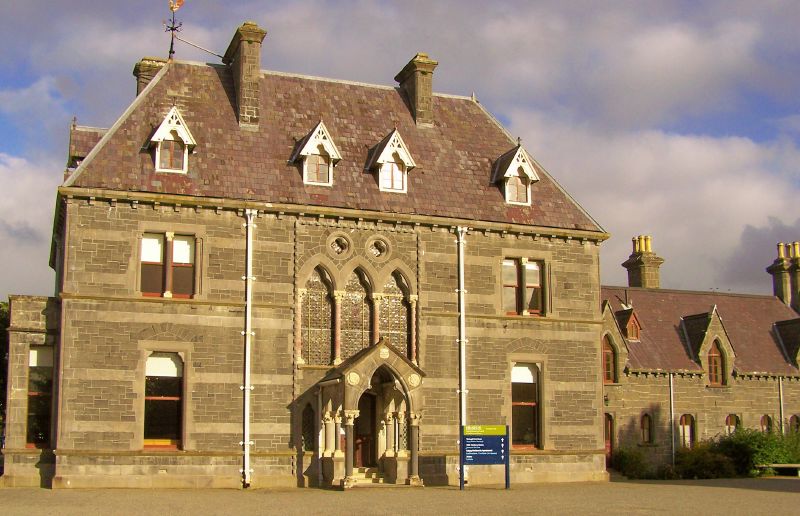|
Séamus Ó Duilearga
Séamus Ó Duilearga (born James Hamilton Delargy; 26 May 1899 – 25 June 1980) was an Irish folklorist, professor of folklore at University College Dublin and Director of the Irish Folklore Commission. Born in Cushendall, Co Antrim, he was one of two sons of James Delargy and Mary Josephine McQuillan. Following the death of James Delargy the family moved to Glenariff, Co Antrim and later to Co Wicklow. Graduating with a degree in Celtic Studies from University College Dublin, he founded the Folklore of Ireland Society in 1926 and was involved with the foundation of its magazine 'Béaloideas' the following year. He would remain its editor until his retirement. In 1930 the Society became the Irish Folklore Institute and received a government grant, and in 1935 the Irish Folklore Commission (Coimisiún Béaloideasa Éireann) was established in University College Dublin by the first Fianna Fáil government. Ó Duilearga was appointed director and Seán Ó Súilleabháin (1903-19 ... [...More Info...] [...Related Items...] OR: [Wikipedia] [Google] [Baidu] |
University College Dublin
University College Dublin (), commonly referred to as UCD, is a public research university in Dublin, Ireland, and a collegiate university, member institution of the National University of Ireland. With 38,417 students, it is Ireland's largest university. UCD originates in a body founded in 1854, which opened as the Catholic University of Ireland on the feast of Saint Malachy, St. Malachy with John Henry Newman as its first rector; it re-formed in 1880 and chartered in its own right in 1908. The Universities Act, 1997 renamed the constituent university as the "National University of Ireland, Dublin", and a ministerial order of 1998 renamed the institution as "University College Dublin – National University of Ireland, Dublin". Originally located at St Stephen's Green and National Concert Hall, Earlsfort terrace in Dublin's city centre, all faculties later relocated to a campus at Belfield, Dublin, Belfield, six kilometres to the south of the city centre. In 1991, it purchas ... [...More Info...] [...Related Items...] OR: [Wikipedia] [Google] [Baidu] |
Irish Folklore Commission
The Irish Folklore Commission () was set up in 1935 by the Irish Government to study and collect information on the folklore and traditions of Ireland. History Séamus Ó Duilearga (James Hamilton Delargy) founded ''An Cumann le Béaloideas Éireann'' (The Folklore of Ireland Society) and its journal ''Béaloideas'' in 1927. Ó Duilearga prescribed a guideline for gathered oral tradition, for example, insisting that the collected data identified the informant's name and age as well as provenance of material. The Society would not only edit and publish the collected folklore, but endeavor to supply a translation or at least a summary in English or some suitable language. It was a call for the preservation of Irish folklore, and his countrymen heeded the appeal by sending in manuscripts to the Society, and these material would be published in the ''Béaloideas'' periodical. Public sentiment mounted that such a grave undertaking should not be left entirely to a voluntary society, an ... [...More Info...] [...Related Items...] OR: [Wikipedia] [Google] [Baidu] |
The Irish Times
''The Irish Times'' is an Irish daily broadsheet newspaper and online digital publication. It was launched on 29 March 1859. The editor is Ruadhán Mac Cormaic. It is published every day except Sundays. ''The Irish Times'' is Ireland's leading newspaper. It is considered a newspaper of record for Ireland. Though formed as a Protestant Irish nationalist paper, within two decades and under new owners, it became a supporter of unionism in Ireland. In the 21st century, it presents itself politically as "liberal and progressive", as well as being centre-right on economic issues. The editorship of the newspaper from 1859 until 1986 was controlled by the Anglo-Irish Protestant minority, only gaining its first nominal Irish Catholic editor 127 years into its existence. The paper's notable columnists have included writer and arts commentator Fintan O'Toole and satirist Miriam Lord. The late Taoiseach Garret FitzGerald was once a columnist. Michael O'Regan was the Leinster Ho ... [...More Info...] [...Related Items...] OR: [Wikipedia] [Google] [Baidu] |
Film Editing
Film editing is both a creative and a technical part of the post-production process of filmmaking. The term is derived from the traditional process of working with film stock, film which increasingly involves the use Digital cinema, of digital technology. When putting together some sort of video composition, typically, one would need a collection of shots and footages that vary from one another. The act of adjusting the shots someone has already taken, and turning them into something new is known as film editing. The film editor works with raw footage, selecting Shot (filmmaking), shots and combining them into Sequence (filmmaking), sequences which create a finished Film, motion picture. Film editing is described as an art or skill, the only art that is unique to cinema, separating filmmaking from other art forms that preceded it, although there are close parallels to the editing process in other art forms such as poetry and novel writing. Film editing is an extremely important ... [...More Info...] [...Related Items...] OR: [Wikipedia] [Google] [Baidu] |
Oidhche Sheanchais
(; "A Night of Storytelling"; variously given as ''The Storyteller, The Story Teller, Storyteller's Night, Night of Story-telling'') is a 1935 Irish film directed by Robert J. Flaherty, who was also the cinematographer for the film. It was produced during the sound recording session for his more famous docufiction film ''Man of Aran'' in London, and is notable as the first Irish language sync sound film in the Irish Free State period. Production ''Oidhche Sheanchais'' was filmed at Gaumont Studios. Plot Four islanders (who are actually the cast of ''Man of Aran'') are gathered around the hearth. The film begins with an excerpt of a traditional sean-nós song performed by Maggie Tom Ní Mhaoláin (Maggie Dirrane). Seanchaí Seáinín Tom Ó Dioráin tells a traditional story called ''Máirtín Mac an Rí'', a version of the maritime folk legend '' The Knife against the Wave''. In the story, a fisherman successfully defends himself against the onslaught of a supernatural st ... [...More Info...] [...Related Items...] OR: [Wikipedia] [Google] [Baidu] |
Irish Language
Irish (Standard Irish: ), also known as Irish Gaelic or simply Gaelic ( ), is a Celtic language of the Indo-European language family. It is a member of the Goidelic languages of the Insular Celtic sub branch of the family and is indigenous language, indigenous to the island of Ireland. It was the majority of the population's first language until the 19th century, when English (language), English gradually became dominant, particularly in the last decades of the century, in what is sometimes characterised as a result of linguistic imperialism. Today, Irish is still commonly spoken as a first language in Ireland's Gaeltacht regions, in which 2% of Ireland's population lived in 2022. The total number of people (aged 3 and over) in Ireland who declared they could speak Irish in April 2022 was 1,873,997, representing 40% of respondents, but of these, 472,887 said they never spoke it and a further 551,993 said they only spoke it within the education system. Linguistic analyses o ... [...More Info...] [...Related Items...] OR: [Wikipedia] [Google] [Baidu] |
Sync Sound
Sync sound (synchronized sound recording) refers to sound recorded at the time of the filming of movies. It has been widely used in movies since the birth of sound movies. History Even in the silent film era, films were shown with sounds, often with musical accompaniment by a pianist or an orchestra keeping time with the screen action. The first synchronization was a turning recording device marked with a white spot. As the white spot rotated, the cameraman hand-cranked the camera to keep it in sync with the recording. The method was then repeated for playback, but with the projectionist hand cranking the film projector. " Single-system" sound recorded sound optically to part of the original camera film, or magnetically to a stripe of magnetic coating along the film edge. " Double-system" sound used independent cameras and sound recorders. The first sync sound standard used recorders and cameras both powered by AC (alternating current) motors - essentially clock motors. Later ... [...More Info...] [...Related Items...] OR: [Wikipedia] [Google] [Baidu] |
National Museum Of Ireland
The National Museum of Ireland () is Ireland's leading museum institution, with a strong emphasis on national and some international archaeology, Irish history, Irish art, culture, and natural history. It has three branches in Dublin, the archaeology and natural history museums adjacent on Kildare Street and Merrion Square, and a newer Decorative Arts and History branch at the former Collins Barracks, and the Country Life museum in County Mayo. History Predecessors The National Museum of Ireland descends from the amalgamation of parts of the collections of a number of Dublin cultural institutions from the 18th and 19th centuries, including primarily the Royal Dublin Society (RDS) and the Royal Irish Academy (RIA). The earliest parts of the collections are largely geological and mineralogical specimens, which the RDS collected as a means to improve the knowledge and use of such resources in Ireland. The establishment of the museum collections is generally deemed to have ... [...More Info...] [...Related Items...] OR: [Wikipedia] [Google] [Baidu] |
Irish Folklorists
Irish commonly refers to: * Someone or something of, from, or related to: ** Ireland, an island situated off the north-western coast of continental Europe ***Éire, Irish language name for the island and the sovereign state *** Erse (other), Scots language name for the Irish language or Irish people ** Republic of Ireland, a sovereign state ** Northern Ireland, a constituent unit of the United Kingdom of Great Britain and Northern Ireland * Irish language, a Celtic Goidelic language of the Indo-European language family spoken in Ireland * Irish English, set of dialects of the English language native to Ireland * Irish people, people of Irish ethnicity Irish may also refer to: Places * Irish Creek (Kansas), a stream in Kansas * Irish Creek (South Dakota), a stream in South Dakota * Irish Lake, Watonwan County, Minnesota * Irish Sea, the body of water which separates the islands of Ireland and Great Britain People * Irish (surname), a list of people * William Irish, pse ... [...More Info...] [...Related Items...] OR: [Wikipedia] [Google] [Baidu] |
1899 Births
Events January * January 1 ** Spanish rule formally ends in Cuba with the cession of Spanish sovereignty to the U.S., concluding 400 years of the Spanish Empire in the Americas.''The American Monthly Review of Reviews'' (February 1899), pp. 153-157 ** In Samoa, followers of Mataafa, claimant to the rule of the island's subjects, burn the town of Upolu in an ambush of followers of other claimants, Malietoa Tanus and Tamasese, who are evacuated by the British warship HMS ''Porpoise''. ** Queens and Staten Island become administratively part of New York City. * January 2 – Theodore Roosevelt is inaugurated as Governor of New York at the age of 39. * January 3 – A treaty of alliance is signed between Russia and Afghanistan. * January 5 – **A fierce battle is fought between American troops and Filipino defenders at the town of Pililla on the island of Luzon. *The collision of a British steamer and a French steamer kills 12 people on the English Channel. * Jan ... [...More Info...] [...Related Items...] OR: [Wikipedia] [Google] [Baidu] |




